
Great Sand Dunes National Park and Preserve is an American national park that conserves an area of large sand dunes up to 750 feet (230 m) tall on the eastern edge of the San Luis Valley, and an adjacent national preserve in the Sangre de Cristo Range, in south-central Colorado, United States. The park was originally designated Great Sand Dunes National Monument on March 17, 1932, by President Herbert Hoover. The original boundaries protected an area of 35,528 acres. A boundary change and redesignation as a national park and preserve was authorized on November 22, 2000, and then established on September 24, 2004. The park encompasses 107,342 acres while the preserve protects an additional 41,686 acres for a total of 149,028 acres. The recreational visitor total was 527,546 in 2019.
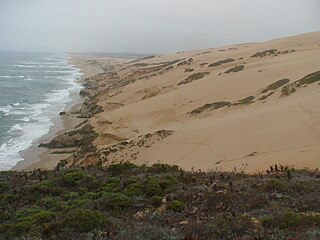
Guadalupe-Nipomo Dunes is the largest remaining dune system south of San Francisco and the second largest in the U.S. state of California. It encompasses an 18-mile (29 km) stretch of coastline on the Central Coast of California and extends from southern San Luis Obispo County to northern Santa Barbara County.

The Algodones Dunes is a large sand dune field, or erg, located in the southeastern portion of the U.S. state of California, near the border with Arizona and the Mexican state of Baja California. The field is approximately 45 miles (72 km) long by 6 miles (9.7 km) wide and extends along a northwest-southeast line that correlates to the prevailing northerly and westerly wind directions. The name "Algodones Dunes" refers to the entire geographic feature, while the administrative designation for that portion managed by the Bureau of Land Management is the Imperial Sand Dunes Recreation Area. In 1966, Imperial Sand Hills was designated as a National Natural Landmark by the National Park Service. The Algodones Dunes are split into many different sections. These sections include Glamis, Gordon's Well, Buttercup, Midway, and Patton's Valley. Although the Arabic-derived Spanish word algodones translates to "cotton plants", the origin of the toponym is unknown.
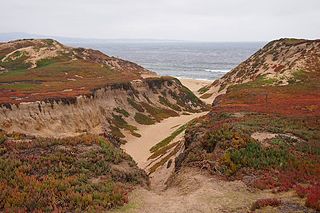
Fort Ord Dunes State Park is a state park in California, United States, along 4 miles (6.4 km) of coastline on Monterey Bay and created from part of the closed Fort Ord. The park includes a boardwalk, a path to the beach, a 4-mile (6.4 km) road for walking and biking, and interpretive exhibits describing its former use as a military training area. As the dunes are a nesting area for sensitive species, public access is limited to the paths and trails.

Ammophila arenaria is a species of grass in the family Poaceae. It is known by the common names marram grass and European beachgrass. It is one of two species of the genus Ammophila. It is native to the coastlines of Europe and North Africa where it grows in the sands of beach dunes. It is a perennial grass forming stiff, hardy clumps of erect stems up to 1.2 metres (3.9 ft) in height. It grows from a network of thick rhizomes which give it a sturdy anchor in its sand substrate and allow it to spread upward as sand accumulates. These rhizomes can grow laterally by 2 metres in six months. One clump can produce 100 new shoots annually.
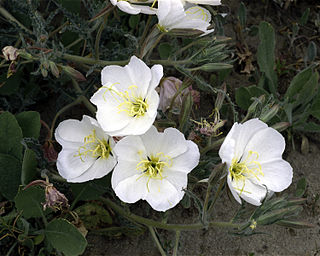
Antioch Dunes National Wildlife Refuge is a sensitive sand dune habitat located near the city of Antioch, California on the south shore of the San Joaquin River-Stockton Deepwater Shipping Channel. It serves as a refuge for three endangered species of plants and insects, and is closed to the public except for tours and events supervised by Refuge staff. The Refuge was established in 1980. It is managed by the U.S. Fish and Wildlife Service.
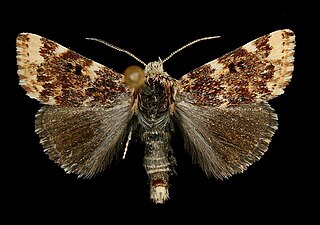
Schinia avemensis, the gold-edged gem, is a moth of the family Noctuidae. The species was first described by Harrison Gray Dyar Jr. in 1904. It is found in only three colonies in the southern prairie provinces of Canada, the Spirit Dunes at Spruce Woods Provincial Park, Manitoba; the Burstall dunes in south-western Saskatchewan; and in a small dune complex in the Red Deer River valley north of Bindloss. It will probably also be found in other active dune complexes in the southern parts of Alberta and Saskatchewan. It has also been recorded from Colorado.

The Guadalupe-Nipomo Dunes National Wildlife Refuge is a 2,553-acre (10.33 km2) protected area located along the Central Coast of California, in southern San Luis Obispo and northern Santa Barbara Counties.
Agrotis gravis is a moth of the family Noctuidae. It is found from British Columbia, south to California.
Euxoa aurulenta, the dune cutworm, is a moth of the family Noctuidae. The species was first described by Smith in 1888. It is found in North America from Ontario west to Alberta and Washington, south to Illinois, Nebraska, Colorado and Arizona.

Schinia lynda is a moth of the family Noctuidae. It is only known from the dunes in the high desert of south-central Oregon.

Psammopolia arietis is a moth of the family Noctuidae. It occurs on Pacific Coast sand beaches from Mendocino, California to south-western Alaska. It is absent from the inland Strait of Georgia.

Euxoa muldersi is a moth of the family Noctuidae. It is known only from north central Canada with all specimens except two from the vicinity of Arviat, Nunavut. It is restricted to open dunes where it flies close to the sand.

Ponometia semiflava, the half-yellow or yellow-cloaked midget, is a moth of the family Noctuidae. The species was first described by Achille Guenée in 1852. It is found in North America from New York and New England to Florida, west to Arizona, north to British Columbia and Manitoba.

Aleptina arenaria is a moth of the family Noctuidae. It is only known from the White Sands National Park, Otero County, New Mexico.
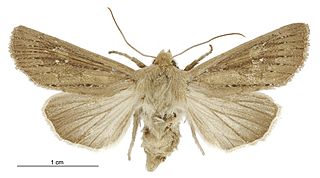
Ichneutica phaula is a moth of the family Noctuidae. It is endemic to New Zealand. It is found only in the South Island in the Nelson district, the eastern side of the South Island and Stewart Island. I. phaula inhabits tussock grasslands and coastal sand dunes. Host species include Ficinia spiralis, Ammophila arenaria, Poa cita and other "tussock grasses". The adults of this species are on the wing from October to December and are attracted to sugar traps. I. phaula is similar in appearance to both I. micastra, with whom it does not share a range, and I. sapiens which differs from I. phaula as I. sapiens is darker and has a more reddish tinge.

Ichneutica unica is a species of moth in the family Noctuidae. It is endemic to New Zealand and is found in the centre of the North Island and throughout the South Island. This moth is very similar in appearance to its close relatives Ichneutica phaula and Ichneutica toroneura. I. phaula can be distinguished as there is a difference in pectinations on the male antennae and I. toroneura can be distinguished as the black vein markings on the forewings is more uniform for that species in comparison to I. unica. I. unica is variable in appearance with the North Island specimens having a darker brown colour on the forewings and having a darker underside of the hindwings. This species inhabits open tussock grassland at various altitudes, coastal dunes, and inland volcanic dunes. Larvae feed on tussock grasses such as Chionochloa pallens and species in the genus Poa. Adult moths are on the wing from November to February and are attracted to both sugar and light traps.

Sympistis infixa, the broad-lined sallow moth, is a moth in the family Noctuidae. It was described by Francis Walker in 1856 and is found in North America.
Sympistis kelsoensis is a species of moth in the family Noctuidae. It is found in North America.
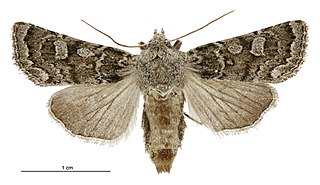
Ichneutica sistens is a moth of the family Noctuidae. This species is endemic to New Zealand. It can be found in the central North Island and throughout the South Island, although it is more common on the eastern side of that latter Island. It is very variable in both colour and size. I. sistens prefers open habitat such as tussock grasslands, dunes and braided rivers. Larval host species include grasses in the family Poaceae and include species in the genera Rytidosperma and Elymus, as well as Poa cita and Agrostis capillaris. Adults are on the wing from January to May and are attracted to light.














